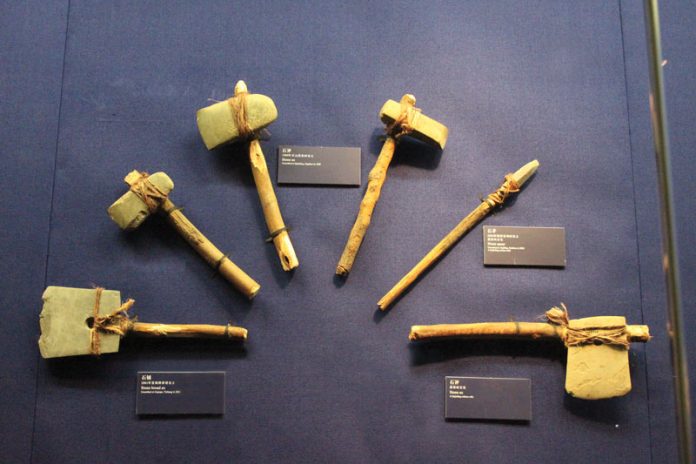
Ancient artifacts show that mankind has been killing animals and fellow humans for millions of years. Our crafty ancestors made the most of the natural world to create what they needed from the materials at hand. There is evidence that we, as humans, started using rocks as tools (to start fires) and weapons (flint for arrowheads) as early as 2.6 million years ago, ushering in the era known not unsurprisingly as the Stone Age.
The Stone Age
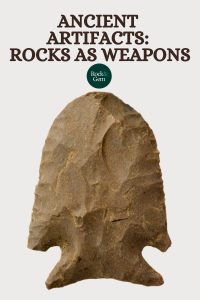
The Stone Age lasted until the end of the Neolithic era when we learned to start using metals and transitioned into the Bronze Age. The Stone Age is three distinct periods recognized by researchers, known as the Paleolithic, Mesolithic and Neolithic eras. The suffix lithic means “stone.”
Most of the Stone Age occurred within the Ice Age. Early humans hunted the Megafauna of this period such as saber-toothed cats, mammoths, mastodons, giant sloths, giant bison and relatives of the modern deer. Weapons were needed to kill these animals for food, to take their hides for clothes, warmth and protective structures, and to use their bones for numerous purposes.
The Stone Age Eras
The longest of the Stone Age eras was the first. The Paleolithic era lasted just shy of 2.5 million years, ending between 11700 and 9600 BCE. The stone tools and weapons from this era are known as Oldowan and Acheulean. Several cave paintings date back to this era and depict scenes of stone weapons. The end of this period coincides with the end of the ice age.
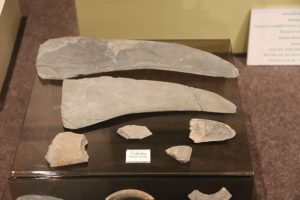
Middle Stone Age
Dates for the Middle Stone Age, or the Mesolithic era, are harder to pin down. This period represented an advancement in weapon and tool-making skills and is greatly regional since there was not a whole lot of exchanging of ideas and technologies. In some parts of the world, it began as late as 8,000 BCE. Regardless of the exact dates, it was the shortest of the three eras. It is notable though for many advancements in weapon and tool-making skills. Weapons associated with this era were chisel-pointed burins (akin to awls), blades and backed knives, scrapers, cutting tools known as tranchet adzes and multi-purpose tools.
Neolithic Era
The Neolithic era, also the last era, began as early as 8,000 BCE in some parts of the world and ended between 3,000 and 2,700 BCE. This was the last period where humans relied exclusively on stone, bone, antler, or wood weapons and started experimenting with metals. Stonehenge dates back to this period. Agriculture became more prominent during this time and a lot of stone weapons and tools were used for digging and farming. This period saw the rise or continued improvements to adzes, arrows, axes, blades, chisels, and other dual-purpose tools used for digging and striking.
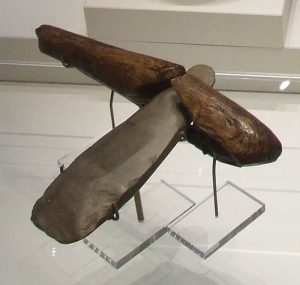
Axes and Knife-like Weapons
Axes were broadly used throughout much of the Stone Age. Axes were useful in close combat, good for clearing a path while in pursuit of their target, but even more so when preparing a kill to be eaten. As the millennia progressed, so too did the shape and sharpness of the stone axes our forebears made. By about 320,000 years ago, axes had evolved from larger, fist-sized axes, to smaller and more sophisticated blades and points. A specific type of ax was developed, known as a “chopper.” This was used for more detailed work such as dividing up meat or cutting into skin and fur.
Blades and scrapers were crafted from smaller, sharper stones than those used typically for axes. There was no uniformity in their overall size or weight. A tribe, clan or family might have several different sizes to be used as each circumstance dictated. When made of obsidian, these blades were especially sharp. As time went forward, and agriculture developed, these would be affixed to longer sticks and become the world’s first scythes.
Timeline of Stone Weaponry(Dates are Approximate) 1.2 million – 500,000 years ago – Stone hand axes were primarily used. 500,000- 400,000 years ago – First evidence of spears. This may however be drastically off. A current population of modern chimpanzees in Senegal uses spears to hunt. This might suggest that the common ancestry of both humans and apes used this technology and that it was passed down millions of years ago. 320,000-300,000 years ago – Projectile points began to diversify for various types of weapons, including hafted tips. 40,000 to 25,000 years ago – The “Atlatl” was developed. It was a method of throwing a stone-tipped dart or spear that was likely the progenitor of the bow and arrow. 25,000- 3,000 years ago – Further refinement of projectile points, including scalpels used for rudimentary surgery. The Bronze age brought a new era of weapon and tool making. Fun Fact: Almost all discovered stone weapons were developed for right-hand use, suggesting this has been the dominant trait in the human timeline for millions of years. |
Projectile Points
Projectile points were used for arrows, spears and harpoons. The traditional arrowhead is among this group. Projectile points were the premium weapons for hunting. Early humans located near water utilized this technology to make harpoons for hunting fish and larger marine life. Evidence suggests that early mankind was adept enough at using harpoons, they could spear larger fish, including swordfish and whales. Rope was attached to the harpoon shaft so the kill could be pulled to shore.
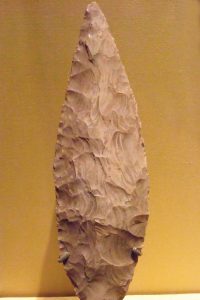
Photographed at the Metropolitan Museum of Art in New York City, New York.
As soon as early humans learned how to create composite tools, they affixed sharpened, triangularly pointed stones onto the end of a wooden shaft and adhered them with sinew or plant fibers. As the handle part of these composite tools has long since decomposed, it can be difficult to know whether a projectile was affixed to an arrow or a spear, so researchers do not make that distinction.
Around 300,000 years ago, humans began to adhere projectile points to sticks via a method known as hafting. This allowed the pointed stone and stick to be a singular weapon, much less cumbersome than previous methods. Skilled weapons makers would use fire and heat to perfect this attachment. Initially, these would have been used for jabbing, until the advent of the Atlatl — a device that evolved into the bow. It acted as an extension of the arm and allowed projectiles to be hurled much farther and faster with more accuracy.
Slingstones
An overlooked category of stone weapons is the sling stone. This is probably because not all sling stones were honed to a particular size or shape. They were potentially used in the form they were found. These first appeared late in the Stone Age. Piles of sculpted, similarly-sized, oval or oblong rocks with pointed ends have been found in parts of the Middle East.
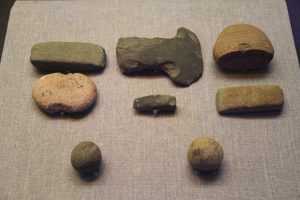
When used in their found form, these are the most rudimentary of weapons. When formed with pointed ends into roughly uniform size, and intended to be flung with some kind of a sling, this evidences great thought and advancement. This allowed for greater accuracy because a formal size could be used for practice. Besides their obvious use in combat or hunting, these sling stones are also thought to have been used to aid herders when controlling predators and steering a flock. Scientists assume this because sling stones are often found in areas where flocks were located.
Multi-Functional Tools & Weapons
As the Stone Age came to a close, early humans became adept at making multi-use weaponry. This makes sense as it reduced the number of things to carry and is evidence of the evolution of stone weapon making. A single stone weapon/tool from the Mesolithic could simultaneously have one side that was used as a knife, one side as a hammer or striking surface, and one side as a scraper. As farming arose, the need to dig into the soil and clear land became important as well.
It was not uncommon for some skilled tool and weapon makers to have actual tool kits of stones to do a variety of tasks. Regional differences have been found suggesting these skills were passed down and that communities had distinct identities or cultures.
This story about the ancient artifacts previously appeared in Rock & Gem magazine. Click here to subscribe. Story by Chris Bond.













